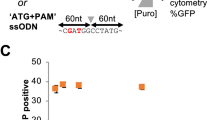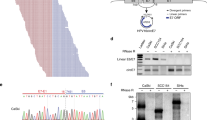Abstract
E6AP was originally identified as the ubiquitin–protein ligase involved in human papillomavirus (HPV) E6-mediated p53 degradation and has since been shown to act as an E3 ubiquitin–protein ligase in the ubiquitination of several other protein substrates. To further define E6AP function at the molecular and cellular levels, a ribozyme-based gene inactivation approach was adopted. A library of hammerhead ribozymes, with randomized arm sequences, was used to screen active molecules along the entire E6AP transcript for ribozyme-cleavable sites. Ligation-anchored PCR was adapted to detect cleavage products, and ribozymes designed to the selected sites were characterized both in vitro and in vivo. Ribozyme-mediated reduction in E6AP expression was found to enhance the apoptotic response of HeLa cells to mitomycin C-induced DNA damage. These findings suggest that E6AP has potential as a drug target, as its suppression can potentiate apoptosis in HPV-positive cells treated with a cytotoxic drug.
This is a preview of subscription content, access via your institution
Access options
Subscribe to this journal
Receive 12 print issues and online access
$259.00 per year
only $21.58 per issue
Buy this article
- Purchase on Springer Link
- Instant access to full article PDF
Prices may be subject to local taxes which are calculated during checkout







Similar content being viewed by others
References
Peters J-M, Harris JR, Finley D . Ubiquitin and the Biology of the Cell. New York: Plenum Press; 1998: 472 pp.
Scheffner M, Huibregtse JM, Vierstra RD, Howley PM . The HPV-16 E6 and E6-AP complex functions as a ubiquitin–protein ligase in the ubiquitination of p53. Cell. 1993;75:495–505.
Gross-Mesilaty S, Reinstein E, Bercovich B, et al. Basal and human papillomavirus E6 oncoprotein-induced degradation of myc proteins by the ubiquitin pathway. Proc Natl Acad Sci USA. 1998;95:8058–8063.
Kuhne C, Banks L . E3-ubiquitin ligase/E6-AP links multicopy maintenance protein 7 to the ubiquitination pathway by a novel motif, the L2G box. J Biol Chem. 1998;273:34302–34309.
Thomas M, Banks L . Inhibition of Bak-induced apoptosis by HPV-18 E6. Oncogene. 1998;17:2943–2954.
Oda H, Kumar S, Howley PM . Regulation of the src family tyrosine kinase blk through E6AP-mediated ubiquitination. Proc Natl Acad Sci USA. 1999;96:9557–9562.
Kumar S, Talis AL, Howley PM . Identification of HHR23A as a substrate for E6-associated protein-mediated ubiquitination. J Biol Chem. 1999;274:18785–18792.
Huibregtse JM, Scheffner M, Beaudenon S, Howley PM . A family of proteins structurally and functionally related to the E6-AP ubiquitin–protein ligase. Proc Natl Acad Sci USA. 1995;92:2563–2567.
Nawaz Z, Lonard DM, Smith CL, Lev-Lehman E, Tsai SY, O'Malley BW . The Angelman Syndrome-associated protein, E6-AP, is a coactivator for the nuclear hormone receptor superfamily. Mol Cell Biol. 1999;19:1182–1189.
Matsuura T, Sutcliffe JS, Fang P, et al. De novo truncating mutations in E6-AP ubiquitin–protein ligase gene (UBE3A) in Angelman syndrome. Mol Cell Biol. 1997;15:74–77.
Kishino T, Lalande M, Wagstaff J . UBE3A/E6-AP mutations cause Angelman syndrome. Nat Genet. 1997;15:70–73.
Haseloff J, Gerlach WL . Simple RNA enzymes with new and highly specific endoribonuclease activities. Nature. 1988;334:585–591.
Campbell TB, Cech TR . Identification of ribozymes within a ribozyme library that efficiently cleave a long substrate RNA. RNA. 1995;1:598–609.
Birikh KR, Berlin YA, Soreq H, Eckstein F . Probing accessible sites for ribozymes on human acetylcholinesterase RNA. RNA. 1997;3:429–437.
Yu Q, Pecchia DB, Kingsley SL, Heckman JE, Burke JM . Cleavage of highly structured viral molecules by combinatorial libraries of hairpin ribozymes. J Biol Chem. 1998;273:23524–23533.
Pan WH, Devlin HF, Kelley C, Isom HC, Clawson GA . A selection system for identifying accessible sites in target RNAs. RNA. 2001;4:610–621.
Pan WH, Xin P, Bui V, Clawson GA . Rapid identification of efficient target cleavage sites using a hammerhead ribozyme library in an iterative manner. Mol Ther. 2003;1:129–139.
Lieber A, Strauss M . Selection of efficient cleavage sites in target RNAs by using a ribozyme library. Mol Cell Biol. 1995;15:540–551.
Troutt AB, McHeyzer-Williams MG, Puledndran B, Nossal GJV . Ligation-anchored PCR: a simple amplification technique with single-sided specificity. Proc Natl Acad Sci USA. 1992;89:9823–9825.
Cairns MJ, Hopkins TM, Witherington C, Wang L, Sun L-Q . Target site selection for an RNA-cleaving catalytic DNA. Nat Biotechnol. 1999;17:480–486.
Heidenreich O, Eckstein F . Hammerhead ribozyme-mediated cleavage of the long terminal repeat RNA of human immunodeficiency virus type 1. J Biol Chem. 1992;267:1904–1909.
Heidenreich O, Benseler F, Fahrenholz A, Eckstein F . High activity and stability of hammerhead ribozymes containing 2′-modified pyrimidine nucleosides and phosphothioates. J Biol Chem. 1994;269:2131–2138.
Butz K, Shahabeddin L, Geisen C, Spitkovsky D, Ullmann A, Hoppe-Stoppler F . Functional p53 protein in human papillomavirus-positive cancer cells. Oncogene. 1995;10:927–936.
Tessier DC, Brousseau R, Vernet T . Ligation of single-stranded oligodeoxyribonucleotides by T4 RNA ligase. Anal Biochem. 1986;158:171–178.
Ruffner DE, Stormo GD, Uhlenbeck OC . Sequence requirements of the hammerhead RNA self-cleavage reaction. Biochemistry. 1990;29:10695–10702.
Perriman R, Delves A, Gerlach WL . Extended target-site specificity for a hammerhead ribozyme. Gene. 1992;113:157–163.
Scheffner M, Nuber U, Huibregtse JM . Protein ubiquitination involving an E1–E2–E3 enzyme ubiquitin thioester cascade. Nature. 1995;373:81–83.
Beer-Romero P, Glass S, Rolfe M . Antisense targeting of E6AP elevates p53 in HPV-infected cells but not in normal cells. Oncogene. 1997;14:595–602.
Ho SP, Britton DH, Stone BA, et al. Potent antisense oligonucleotides to the human multidrug resistance-1 mRNA are rationally selected by mapping RNA-accessible sites with oligonucleotide libraries. Nucleic Acids Res. 1996;24:1901–1907.
Edwards JBM, Delort J, Mallet J . Oligodeoxyribonucleotide ligation to single-stranded cDNAs: a new tool for cloning 5′ ends of mRNAs and for constructing cDNA libraries by in vitro amplification. Nucleic Acids Res. 1991;19:5227–5232.
Cairns MJ, Murray V . Influence of chromatin structure on bleomycin–DNA interactions at base pair resolution in the human β-globin gene cluster. Biochemistry. 1996;35:8753–8760.
Mehlen P, Schulze-Osthoff K, Arrigo AP . Small stress proteins as novel regulators of apoptosis. Heat shock protein 27 blocks Fas/APO-1- and staurosporine-induced cell death. J Biol Chem. 1996;271:16510–16514.
Cervellera M, Raschella G, Santilli G, et al. Direct transactivation of the anti-apoptotic gene apolipoprotein J (clusterin) by B-MYB. J Biol Chem. 2000;275:21055–21060.
Postel EH . NM23/nucleoside diphosphate kinase as a transcriptional activator of c-myc. Curr Top Microbiol Immunol. 1996;213:233–252.
Acknowledgements
We thank Dr JM Huibregtse for the gift of the pGEM150-120 E6AP cDNA, Dr PR Daniels for the anti-E6AP polyclonal antibody and Dr WL Gerlach for critical review of the manuscript.
Author information
Authors and Affiliations
Corresponding author
Rights and permissions
About this article
Cite this article
Kim, Y., Cairns, M., Marouga, R. et al. E6AP gene suppression and characterization with in vitro selected hammerhead ribozymes. Cancer Gene Ther 10, 707–716 (2003). https://doi.org/10.1038/sj.cgt.7700623
Received:
Published:
Issue Date:
DOI: https://doi.org/10.1038/sj.cgt.7700623
Keywords
This article is cited by
-
Induction of E6AP by microRNA-302c dysregulation inhibits TGF-β-dependent fibrogenesis in hepatic stellate cells
Scientific Reports (2020)
-
Ubiquitin over-expression promotes E6AP autodegradation and reactivation of the p53/MDM2 pathway in HeLa cells
Molecular and Cellular Biochemistry (2008)
-
Drug discovery in the ubiquitin–proteasome system
Nature Reviews Drug Discovery (2006)
-
Oxidative stress regulated expression of Ubiquitin Carboxyl-terminal Hydrolase-L1: Role in cell survival
Apoptosis (2006)



